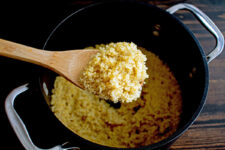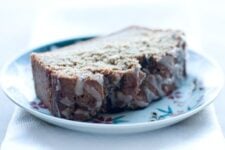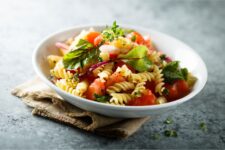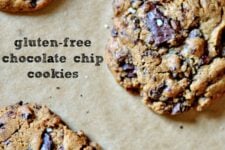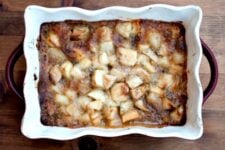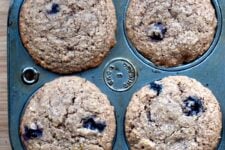Gluten is often targeted as the reason for various health concerns―from digestive diseases to brain fog. But what exactly is gluten, and why do some people need to avoid it?
Gluten is a compound naturally found in wheat, barley, and rye. Though most people don’t need to avoid these foods, the proteins found in gluten can cause symptoms in certain individuals, like those with celiac disease, non-celiac gluten sensitivity, and other gastrointestinal disorders (1).
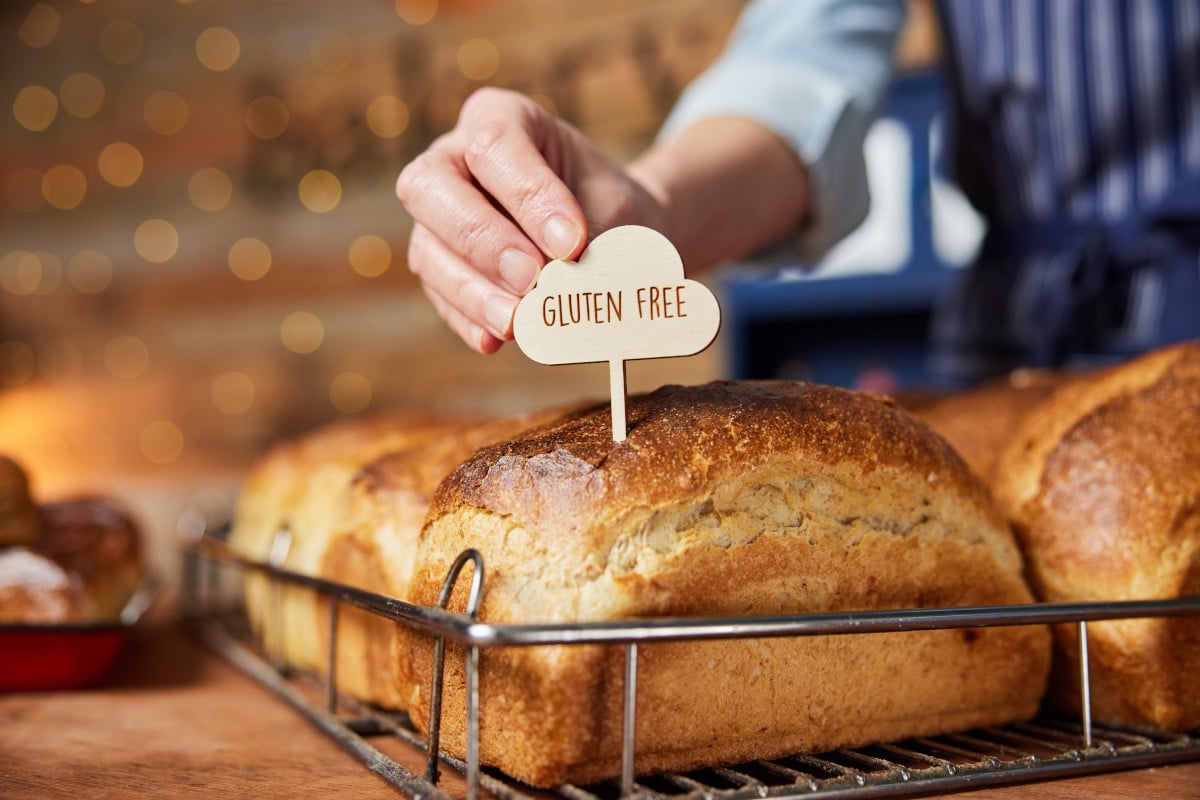
In this article, you’ll find more information on gluten and why some people need to follow a gluten-free diet.
What is Gluten?
Gluten is a protein found in certain grains, specifically wheat, barley, and rye. It’s primarily made up of two proteins: gliadin and glutenin. Gluten-containing grains, especially in their whole form, are important sources of vitamins, minerals, and fiber (1).
Gluten is very prevalent in our food supply, primarily in the form of wheat and wheat products. Wheat flour is commonly used for doughs and baked goods because the gluten content helps the final product stay together (1).
Since gluten is a great binding agent, it’s also added to many unsuspecting foods, like processed meat, food coloring, and canned soups (1, 2).
Why is Gluten a Concern For Some People?
Gluten can affect some people’s digestion in a way that triggers symptoms or causes damage. There are many possible causes of this, including allergies, food intolerance, and autoimmune disease (1).
Celiac Disease
Celiac disease is an autoimmune disorder in which the immune system views gluten as a threat. As a result, when people with celiac disease consume gluten, an immune response is initiated, causing damage to the small intestine in the process (1).
This damage can result in uncomfortable digestive symptoms, making it harder for the body to absorb essential vitamins and minerals. To avoid long-term health consequences, people with celiac disease must follow a strict gluten-free diet (1).
Celiac disease is fairly rare, occurring in about 1% of Americans. Interestingly, the condition has a genetic component, so it can run in families (1).
Wheat Allergy
While there is no such thing as a gluten allergy, many people are allergic to wheat, which contains gluten. A wheat allergy involves an IgE antibody response and is diagnosed through a skin-prick test or a blood test by an allergist (3).
People with a wheat allergy must completely avoid eating wheat and wheat products to avoid an allergic reaction. Since it is not a gluten allergy, these individuals can typically eat other sources of gluten, from barley and rye (1).
Wheat allergies are most common in children, and many outgrow the allergy during childhood. Only 0.4% of people are allergic to wheat worldwide (1).
Non-Celiac Gluten Sensitivity
It’s possible to be gluten sensitive without having celiac disease or a wheat allergy. This sensitivity is known by a few different names, including “non-celiac gluten sensitivity,” “gluten-sensitive enteropathy,” or “gluten intolerance (4).”
A food intolerance differs from an allergy because no antibody response is involved. There also isn’t an autoimmune component causing damage to the intestines like in celiac disease (4).
Though blood tests for food intolerances are gaining popularity (known as IgG tests), no test has been shown to diagnose gluten sensitivity accurately. This condition is diagnosed when a patient has consistent symptoms after eating gluten and tests negative for celiac disease, wheat allergy, and other digestive diseases (4).
Irritable Bowel Syndrome
Irritable bowel syndrome (IBS) is a digestive disorder affecting up to 15% of Americans. It causes symptoms like abdominal pain, diarrhea, constipation, gas, and bloating (5).
Some evidence suggests a link between IBS and gluten-related disorders like celiac disease and gluten sensitivity, but more research is needed to understand this connection fully (5).
However, studies show that a gluten-free diet can improve digestive symptoms in some people with IBS (5). It’s important to discuss any dietary interventions with a registered dietitian specializing in gastrointestinal disorders to ensure their safety and effectiveness.
How Does Gluten Affect the Body?
Though gluten is often vilified in the media, research shows it’s safe for most people to consume. It’s not considered harmful unless you have a gluten-related condition, like celiac disease or a wheat allergy (6).
Gluten is found in many whole grains, and a diet rich in whole grains has been linked with improvements in heart disease, cholesterol, blood sugar, and digestion (6).
In addition, there can be nutritional downsides to a gluten-free diet. Research shows that people on a gluten-free diet tend to have an inadequate intake of essential nutrients like calcium, iron, and fiber (6).
Processed gluten-free products tend to be higher in saturated fat and sodium than gluten-containing items (6). If you need to follow a gluten-free diet for medical reasons, working with a registered dietitian can help ensure your diet’s nutritional quality and balance.
Symptoms of Gluten Sensitivity or Intolerance
Gliadin, one of the proteins found in gluten, can be difficult for some people to digest, resulting in a number of adverse reactions in sensitive individuals (1). Common symptoms of gluten intolerance include (3, 4, 7):
- Stomach cramps.
- Diarrhea.
- Bloating.
- Constipation.
- Fatigue.
- Headache.
- Joint pain.
- Skin rash.
If you suspect you have a gluten intolerance, it’s important to rule out other gluten-related conditions with your healthcare professional, like celiac disease and a wheat allergy. These conditions tend to have overlapping symptoms, sometimes leading to a lack of proper diagnosis (3).
Gluten-Free Diet
It can feel overwhelming if you’re told you must follow a gluten-free diet for medical reasons. In most cases, this is a lifelong change that involves closely monitoring your food choices.
The more you understand which foods tend to contain gluten, the easier it will be to identify items that are off-limits.
Foods that Contain Gluten
Wheat, barley, and rye are the primary sources of gluten, and these ingredients are used in many processed foods (2). Though not an extensive list, here are some of the most gluten-containing foods:
- Bread, baked goods, and other products made with wheat flour, like crackers
- Foods that use wheat flour/starch as a thickener, like soups, sauces, or salad dressings
- Cereal
- Pasta
- Rye bread
- Triticale
- Beer
- Soy sauce
- Oats (if not certified gluten-free)
People who need to follow a very strict gluten-free diet for celiac disease or a wheat allergy must also be aware of cross-contamination. This occurs when a gluten-free item is processed alongside gluten-containing items (3).
This can occur in the home, like using the same toaster for regular bread and gluten-free bread, and it can also happen commercially. In this case, it would be disclosed on the food label that the product was processed in a facility containing wheat (3).
Gluten-Free Alternatives and Substitutes
Many naturally gluten-free foods exist, as well as products formulated with alternate ingredients to make them gluten-free. Look for the “Certified Gluten Free” label on food packaging to ensure the product is acceptable (3, 4).
Examples of gluten-free foods include:
- Rice (brown rice, white rice, rice cakes, rice crackers, rice pasta, rice cereal)
- Corn (corn on the cob, polenta, corn tortillas, corn chips)
- Quinoa
- Potatoes
- Buckwheat
- Amaranth
- Millet
- Sorghum
- Teff
- Tamari (an alternative to soy sauce)
- Gluten-free pasta made with chickpea, lentil, or rice flour
- Gluten-free oats and oat products
- Other certified gluten-free products, like crackers, pretzels, cereals, etc)
If you’re ready to start using some of those ingredients, Healthy Green Kitchen features a full archive of gluten-free recipes. Enjoy!


